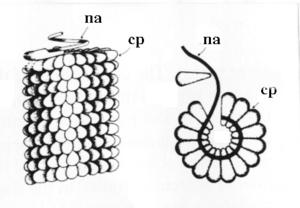About Viruses
| About Plant Viruses What are they and what do we do about them |
||
|
An Electron Micrograph of a Flexuous Rod Virus (courtesy of M. Petersen) |
What is a virus? Viruses are among the smallest and simplest entities that can cause disease. They can only be seen when magnified thousands of times using an electron microscope(left) and for the most part they are made of only two basic chemicals. These chemicals are nucleic acid (either RNA or DNA) and protein (right). There are over 2000 known viruses and about one-fourth of these known viruses attack and cause diseases in plants. |
Basic virus structure - nucleic acid (na) wrapped in a protein coat (pc) |
|
A Mosaic Pattern |
Symptoms Because viruses are microscopic, the presence of a virus is only noticed if it produces recognizable symptoms in the organism it is infecting. In plants these symptoms include mosaic patterns (left), flower break (right), deformed growth, chlorosis or yellowing(below), stunting and leaf distortion, ringspots (below right) , and vein clearing (below left). Unfortunately not all viruses cause dramatic symptoms and sometimes virus-like symptoms can be caused by other things such as environmental factors, insect damage, or improper nutrition. Therefore diagnosis can not be done by symptoms alone. |
Flowerbreak Symptoms in an Orchid Flower |
|
Vein Clearing |
Leaf Chlorosis or Yellowing |
Ring Patterns |
|
Aphids: plant virus vectors |
How do viruses work? Viruses can only reproduce in living cells. To do that they utilize cellular substances that the plant would ordinarily use for its own growth. Consequently a virus disrupts normal function of the cell causing the symptoms we see above. To spread, most virus are dependent on a vector. Plant virus vectors include insects like aphids (right), thirps( left), whiteflies, and leafhoppers. They are also spread by the actions of human beings. |
Thirps: a plant virus vector |
| Prevention includes:
|
How do we control viruses? Once a plant is infected with a virus there is little that can be done. Therefore the best means of control are prevention and eradication. |
Eradication includes:
And:
|

|
A cooperative project of the University of Florida Institute of Food and Agricultural Sciences, Plant Pathology Department, Florida Extension Plant Disease Clinic and the Florida Department of Agriculture and Consumer Services, Division of Plant Industry, Bureau of Entomology, Nematology and Plant Pathology. Both are located in Gainesville FL. | 
|









